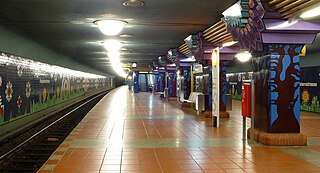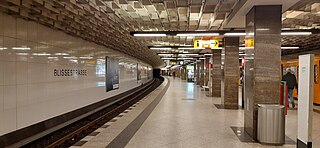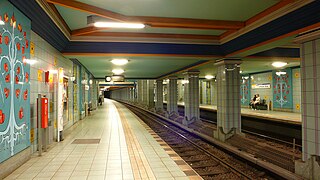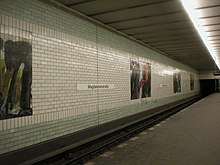
Paulsternstraße is a station on the Berlin U-Bahn line U7. It was opened on 1 October 1984, with the line's extension from Rohrdamm to Rathaus Spandau. Its name means "Paul Stern Street" in English, Paul Stern having been the name of a pub owner after whom a Spandau neighbourhood was named. The station's interiors are notable for the large and colorful mosaics which decorate almost all walls. All signs spell "Paulsternstrasse".

Strausberger Platz is a Berlin U-Bahn station located on the U5 line.

Kurt-Schumacher-Platz is a station on the U6 line of the Berlin U-Bahn. There had been a bus link outside the station connecting Berlin's Tegel International Airport to the U-Bahn network. The station was opened on 3 May 1956 and named after famous German politician Kurt Schumacher.

Wuhletal is a railway station in the Kaulsdorf district of the Marzahn-Hellersdorf borough of Berlin. It is served by the S-Bahn line S5 and the U-Bahn line U5.

Hellersdorf is a Berlin U-Bahn station located on the U5 line.

Louis-Lewin-Straße is a surface-level Berlin U-Bahn station in the German capital city of Berlin. It is part of the Berlin U-Bahn; the station is located on the U5 line.

Borsigwerke is a Berlin U-Bahn station located on the U6.

Rehberge is a station in the Wedding district of Berlin which serves the U6 line and is operated by the BVG. The station is named for Volkspark Rehberge, the large public park approximately 500m away, a name which literally translates as '(Roe) Deer Mountains'. The station was opened on 3 May 1956, along with the rest of the route between Seestraße and Kurt-Schumacher-Platz.

Reinickendorfer Straße is a Berlin U-Bahn station located on the U6.

Schwartzkopffstraße is a Berlin U-Bahn station located on the U6 line.

Blissestraße is a Berlin U-Bahn station located on the U7. Designed by G. R. Rümmler and opened in 1971, it has a ceiling with cement caskets that reflect the light in an unusual way.

Eisenacher Straße is a Berlin U-Bahn station located on the U7. R.G. Rümmler constructed this station which was opened 1971. The wall is covered with green asbestos cement panels. Since Eisenach is a city near the forest in Thuringia, which is called the green heart of Germany, Rümmler chose green as the color of this station. The next station is Kleistpark.

Lindauer Allee is a Berlin U-Bahn station located on the U8 in Berlin, Germany. Designed by Rainer G. Rümmler, the station opened on 24 September 1994, as part of the extension of the U8 to Wittenau. The station is tiled in green, violet, light blue and yellow with trees depicted on the walls as a reference to road's name Lindau where Lindenbaum = lime tree, Lindau is a town at Lake Constance. Mentionable is the gallery with the balustrade from where the whole station is visible. The only similar galleried view in Berlin is at the station Rathaus Spandau.

Paracelsus-Bad is a Berlin U-Bahn station located on the U8. Designed by R.G. Rümmler and opened in 1987, it was named after the philosopher Paracelsus and the nearby bath bearing his name. The walls are covered with white tiles and black borders, and also several pictures with bathing scenes. The columns are also covered with black and white panels, playing with old architecture of baths.

Rosenthaler Platz is a Berlin U-Bahn station located on the U8. Opened in 1930, the station was designed by Alfred Grenander, making prominent use of orange uranium tiles.

Weinmeisterstraße is a Berlin U-Bahn station located on the U8.

Leinestraße is a Berlin U-Bahn station located on the U8 line.

Birkenstraße is a Berlin U-Bahn station located on the U9 line. It was opened in 1961 by B. Grimmek. There are two entrances to the station, located at the Birkenstraße and Wilhelmshavenerstraße crossroad, on either side of the road. The station's walls are decorated with green tiles in reference to the station's name—the word birke is German for birch tree.

Schloßstraße is a Berlin U-Bahn station located on the U9.

Waldsiedlung was the secure housing zone for the leaders of the German Democratic Republic in Bernau bei Berlin, Brandenburg from 1960 to 1989. Waldsiedlung housed the most senior party members of the ruling Socialist Unity Party of Germany (SED) in relative luxury near Wandlitz, 30 kilometres (19 mi) north of East Berlin, with surrounding areas off-limits to all ordinary citizens.





















